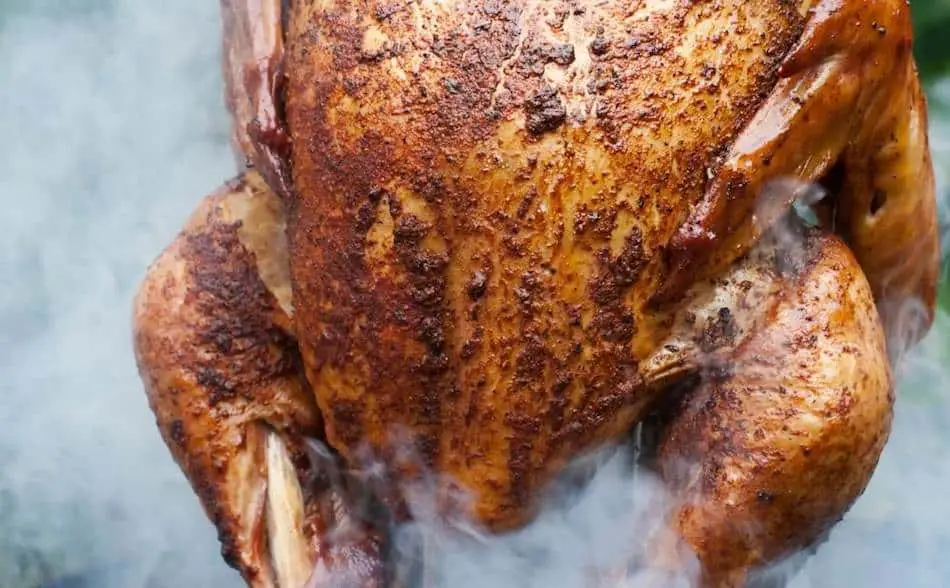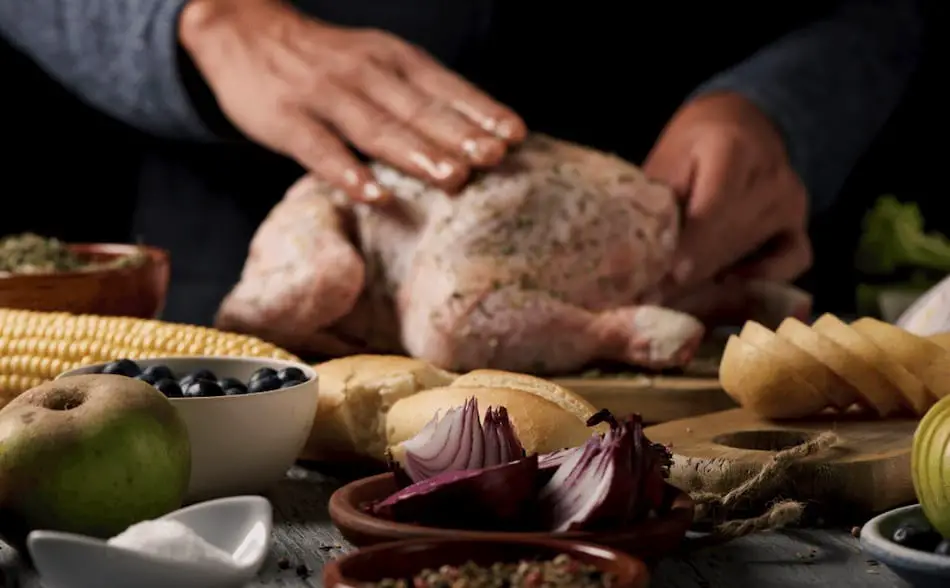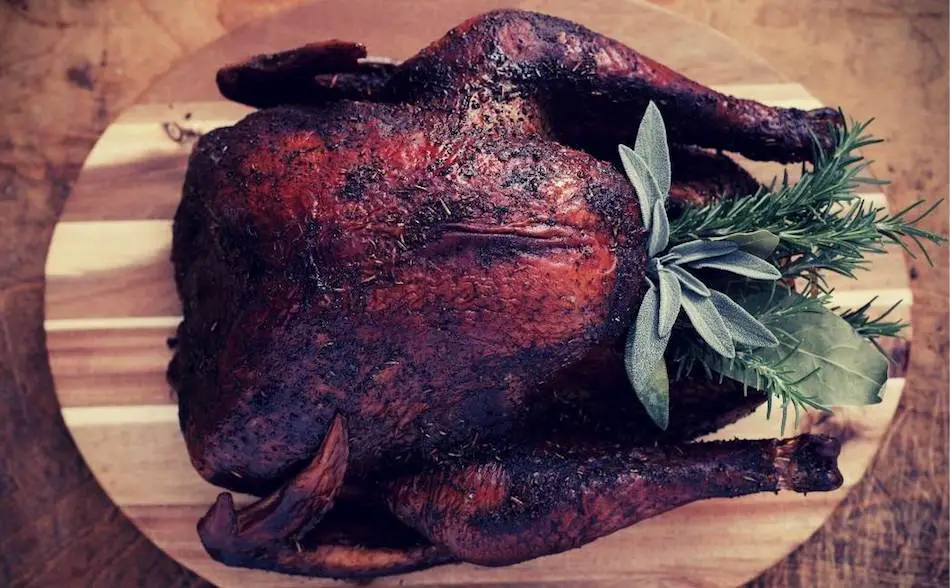
There’s nothing worse than pulling your turkey out of the smoker and having to accept a soft, rubbery skin. Crispy turkey skin should always be the goal, so I wanted to find out everything I could to achieve crispy turkey skin every time. Turns out the answer is fairly straightforward.
So what causes smoked turkey to turn out rubbery? Moisture and low temperatures cause a smoked turkey to have rubbery skin. For a crispy turkey skin, avoid basting, liquid brines, wrapping and tenting. Keep the temperature between 275°-325°F and cover the bird with oil and herbs to help make the skin crispier.
Have you seen the most advanced thermometer on the market? FireBoard can be controlled via your phone, holds meat 6 probes, and records your cook data on a cloud.
9 Ways to Avoid Rubbery Skin on a Turkey
- Don’t cook at a low temperature. Cook at higher temps.
- Don’t tent the turkey.
- Don’t wrap the turkey.
- Don’t baste the turkey.
- Don’t wet brine.
- Don’t sit turkey in a pan.
- Don’t use a water pan.
- Finish off over the hot flames.
- Finish off in the oven at a high temp.
1. Cook Turkey Between 275°F – 325°F
The best temperature to cook a turkey is between 275°- 325°F. Cooking at a lower temperature is the main reason turkey skin will become soft and rubbery. Cooking at a higher temperature will help render some fat from the turkey skin into the meat and make the remaining skin crispy.
The dreaded stall is the other danger you might face if your cooking the turkey below 275°F. The stall is where the internal meat temperature stops rising and “stalls”. Pushing through the stall is one of the most frustrating challenges in low-and-slow cooking. If you cook turkey at higher temperatures, the stall shouldn’t be a problem.
On the other end of the spectrum, you don’t want to raise the temperature too high. Turkey skin is very thin, so if the temperature is too high, the skin will burn.
2. Don’t Tent The Turkey
Avoid tenting if you want a crispy skin on your smoked turkey. Turkey has a thin skin, so hours of smoke will cause blackening. After two-hours, the bird should have taken on enough smoke so the tent is a way of shielding the bird from more smoke. Building a tent with aluminium foil is a common technique to prevent the turkey from darkening in the latter stages of the cook. However, turkey tents cause moisture to get trapped underneath the foil and the steam softens the turkey skin.
If you don’t want a dark turkey, you can still build a tent after about two-hours of smoking, but make sure there’s good airflow around the bird and maintain a high temperature.
3. Don’t Wrap Turkey In Foil
Wrapping meat in the last stages of the cook is usually a way of keeping the meat tender, juicy and moist. The last thing you want at Thanksgiving is a dry bird, but wrapping a turkey in foil isn’t the answer. Like tenting, wrapping the turkey in foil will create too much steam and will cause the turkey skin to become rubbery. So save the foil for your brisket, not your turkey!
Did you know there’s now a meat thermometer with no wires that can control with your phone? Check out MEATER
4. Don’t Baste The Turkey
As with wrapping meat, basting is another technique commonly used to keep meat moist during long cooks. Applying liquid to the turkey will slow the cook and have a cooling effect on the outer layer of the meat. However, basting will do nothing to help you achieve a crispy turkey skin. It will keep the skin moist and rubbery!
5. Avoid Wet Brining Turkey
Soaking your turkey in a brine the day before a cook is a good way of adding flavor and preventing the bird from drying out during the cook. Soaking the bird overnight will cause the skin to soften and will do nothing to help you get a crispy skin. So rather than wet brining, try dry brining instead. If you salt the bird the day before the cook, the salt will penetrate the flesh of the turkey and enhance the flavor. The salt will dry out the skin but will also help the meat retain moisture during the cook.

Dry Brine Instead of Wet Brine Turkey
- Don’t buy a pre-brined turkey. It’s very common to find birds already injected with a brine solution.
- The day before cooking, apply a layer of kosher salt to the turkey.
- Leave the turkey uncovered in the refrigerator to dry out the skin.
6. Don’t Sit The Turkey In A Pan
Make sure you cook your turkey on a cooking grate. This will allow airflow around the bird and help keep the skin crispy. If you sit the turkey in a pan, the meat juices will cause the bottom of the turkey to remain moist, therefore soft, rubbery skin. Some recipes cook turkey in a pan with liquid, but all that does in boil the bird and makes the skin soggy.
7. Don’t Use A Water Pan
Normally using a water pan is a good way of keeping the temperature low and the meat moist. The water pan absorbs some heat and adds moisture to the atmosphere. Water pans are good for long cooks, especially for brisket, pork butts, etc.
8. Finish The Bird Over The Flames
Most smoking setups use an indirect cooking method with the coals on one side of the cooker and the meat on the other. Another way to get a crispy skin is in the final stages of the cook, move the turkey over to the other side of the grill and cook directly over the coals. You want to be careful not to burn the bird, so if you use this trick, use caution.
Most smoking setups use an indirect cooking method with the coals on one side of the cooker and the meat on the other. Another way to get a crispy skin is in the final stages of the cook, move the turkey over to the other side of the grill and cook directly over the coals. You want to be careful not to burn the bird, so if you use this trick, use caution.
Indirect cooking is the best way to do “low-and-slow” cooking. The indirect method also prevents meat juices dripping down onto the fire and having an influence on the makeup of the smoke. Too much smoke from grease can cause the meat to become bitter. It’s okay to have some meat juice drip onto the fire. The burned meat drippings add to the smoke flavor, especially when combined with wood and charcoal.
9. Finish The Turkey In The Oven
Some smokers can’t get hot enough to cook in the 300°F range, therefore it’s difficult to get a crispy turkey skin. Electric and gas smokers usually fall into this category. If you’re cooking a turkey in one of these smokers, the best way around this problem is to finish the bird in a conventional oven. The turkey won’t lose any of the smoke flavor by going in a normal oven because it will have absorbed plenty of smoke in the first few hours of the cook.
Turn the temperature dial on your smoker as high as it will smoke the turkey as usual. Once the internal meat temperature of the turkey hits about 145°F, take it out of the smoker and place it in the conventional oven. Preheat the oven at about 325°F and then raise it to 350°F to 400°F after the bird goes inside. However, make sure you don’t overcook the bird. Monitor the internal meat temperature by inserting a Dot thermometer or a similar leave-in thermometer probe.

The Best Wood For Smoking Turkey
Turkey has a thin flesh, so avoid strong woods such as mesquite, and be careful when using hickory. Cherry is a popular wood for turkey because it gives the bird a nice reddish color.
Dry Rub Recipe For Smoked Turkey
Standard Barbecue Rub

I found this great rub recipe through How To BBQ Right. I use this recipe and alter it slightly depending on what I'm cooking. Made by the guys at Townsend Spice & Supply: https://townsendspice.com/
Ingredients
- - ½ Cup Paprika
- - ½ Cup Salt
- - ½ Cup Sugar
- - ½ Cup Granulated Garlic
- - ¼ Cup Granulated Onion
- - ¼ Cup Chili
- - ¼ Cup Cumin
- - 2 Tablespoons Black Pepper
- - 2 Tablespoons Dry Mustard
- - 1 Tablespoon Cayenne Pepper
Instructions
- Combine all the spices together in a large mixing bowl
- Store rub in rub shakers
Smoking Turkey Isn’t Easy
Turkey is one of the more difficult meats to smoke because there’s a lot you have to get right and lots of things that can go wrong. This is unfortunate, because of all the low-and-slow cooks you do throughout the year, turkey is the one thing you need to get right.
The Best Pre-Made Barbecue Rubs For Turkey
Related:
Why is My Smoked Turkey Black?
The Complete Guide to Smoking Turkey
Why is My Smoked Turkey Tough and Dry?
My Favorite Meat Smoking Tools
Thanks for checking out this article. I hope you learned a few things. Here are some of my favorite tools I use when smoking brisket that may be useful to you. These are affiliate links, so if you decide to purchase any of these products, I’ll earn a commission. But in all honesty, these are the tools I recommend to my family and friends who are just starting out.
Meat Thermometer: There are dozens of fancy thermometers on the market, but I still use my trusty TP20. For around $50, I have a high-quality meat thermometer with two probes, and can track the temperature of my smoker with one probe, and my meat with the other probe. The ThermoPro TP20 is an Amazon Best Seller because it’s the easiest thermometer to operate, is durable, highly accurate, and comes with pre-programmed meat settings.
Instant Read Thermometer: Arguably, the second most important tool you need is a fast and accurate instant-read thermometer. These tools play an important role in the latter stages of the cook when the meat needs regular checking in multiple areas. I use the ThermoPro TP19 because it can do everything a ThermaPen can do, but for a fraction of the cost. You can check out the TP19 on Amazon here.
Wireless Thermometer: The latest thermometers on the market have no wires and can be controlled by wi-fi via your phone. Airprobe 3 is the best of this technology.
Butcher Paper: Wrapping brisket in butcher paper has become a huge trend in barbeque thanks to Aaron Franklin. Wrapping your brisket in paper will give you a nice brisket bark. However, you can’t just use any old paper, it has to be unwaxed, food grade paper. You can find it on Amazon here.
Advanced Thermometer and Automatic Temperature Controller: Once you’re ready to take things seriously, the FireBoard 2 Drive is a six-channel Bluetooth/Wi-Fi thermometer that can monitor up to 6 pieces of meat, control and graph your cook sessions on your smartphone, and attaches to an an automatic blower that will convert your charcoal smoker to a set-and-forget. This is one of the most advanced meat thermometers on the market. You can check it out on the FireBoard website here.
